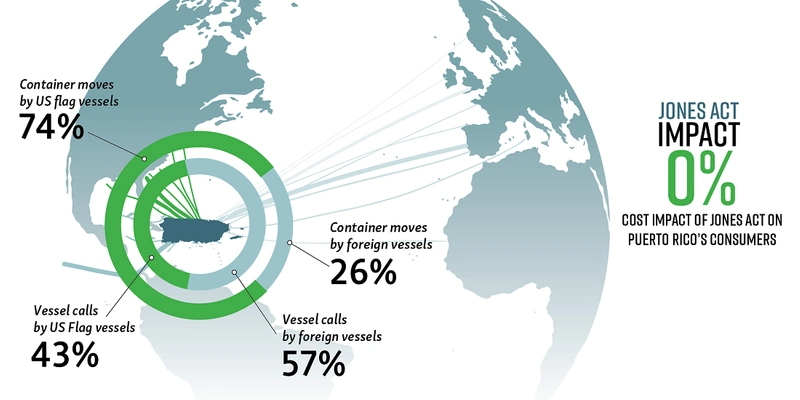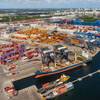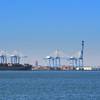The Jones Act is Good for Puerto Rico -Report
After Hurricane Maria struck Puerto Rico with devastating force on September 20, 2017, a number of news reports claimed that the Jones Act had severely damaged the Puerto Rican economy, both over time and in the immediate aftermath of the storm. Now a new report examining the role of the Jones Act shipping industry before, in the immediate aftermath of and in the months that followed the hurricane asserts that the Jones Act fleet delivers a dedicated and reliable flow of goods to the people of Puerto Rico and even provides significant economic benefits for the island.
Economists from Boston-based Reeve & Associates and San Juan-based Estudios Técnicos, Inc. released a joint report, “The Impact of the Jones Act on Puerto Rico,” that concluded the Jones Act has no impact on either retail prices or the cost of living in Puerto Rico. In addition, the report found that the maritime technology, Puerto-Rico-focused investments and dedicated closed-loop service offered by Jones Act carriers provide a significant positive economic impact to the island, at freight rates lower or comparable to similar services to other Caribbean Islands.
In the first comprehensive report on the impact of the Jones Act in Puerto Rico following Hurricane Maria, the authors analyzed the economic impact of the Jones Act, an economic and national security law that ensures goods transported from U.S. port to U.S. port be on vessels that are American crewed, and American built and owned. The report analyzed the impact on consumers by evaluating the competitiveness of freight rates in United States/Puerto Rico markets, the quality of service provided by the Jones Act carriers, and the impact of the carriers’ freight rates on the prices of goods shipped between the U.S. mainland and Puerto Rico.
“There has been much debate about the impact of the Jones Act on Puerto Rico, particularly following Hurricane Maria,” said John Reeve, the principal in Reeve & Associates and the lead economist on the study. “The findings of our analysis show that reliable, efficient, and regular Jones Act services benefit consumers and businesses on the island, and no evidence suggests that exempting Puerto Rico from the Jones Act would reduce consumer prices in Puerto Rico. On the contrary, such an action may well increase prices.”
“The results were overwhelmingly conclusive regarding the economic contributions of the Jones Act to Puerto Rico. Their detailed, fact-based analysis found that Puerto Rico received very similar or lower shipping freight rates when compared to neighboring islands and that the transportation costs have no impact on retail prices on the island,” said Matt Woodruff, Chairman of the American Maritime Partnership. “Moreover, the study found that prior claims and press reports that questioned the value of the Jones Act to Puerto Rico were erroneous and their validity completely undermined when compared to the economic facts at hand.”
In summary, the findings include:
The Jones Act has no impact on either retail prices or the cost of living in Puerto Rico.
The report found that shipping costs between the mainland and Puerto Rico make up only a small percentage of the retail price. For example, ocean shipping accounts for just 3 cents (or two percent) in the retail price of $1.58 for a can of chicken soup in San Juan. It found that, “[e]ssentially, transportation costs for Puerto Rico are not materially different than those on the mainland.”
A market basket analysis of an assortment of consumer goods at Walmart Stores in San Juan, P.R., and Jacksonville, Fla., found there was “no significant difference in the prices of either grocery items or durable goods between the two locations.” In fact, retail prices of goods in Puerto Rico are essentially the same as on the mainland, according to the report.
Foreign vessels can deliver directly to Puerto Rico from foreign countries.
Finding that 57 percent of San Juan’s port traffic in 2016 was carried on foreign vessels, the report noted that there is “nothing in the Jones Act that precludes foreign-flag vessels from serving Puerto Rico directly from foreign countries.” It concluded that there was strong competition between carriers serving the island, stating that “if cargo owners in Puerto Rico believed that the Jones Act shipping services were adding costs that negatively impacted their business, you would expect to see [an increase in foreign flag shipping].”
There is no Jones Act freight rate premium for ocean transport.
The report found that freight rates for shipments between the mainland and Puerto Rico are very similar to or lower than rates for shipping between the mainland and neighboring islands, including the U.S. Virgin Islands, Haiti and the Dominican Republic.
The report refuted assertions in other studies that the negative impact of the Jones Act is $850 million per year, noting that total annual gross revenues for Jones Act shipping services “was substantially below” that level. In other words, “[t]he Jones Act carriers could have provided shipping services for free and… there still would have been a negative economic impact”, according to these studies.
The report found that since 2000, the carriers’ ocean freight rates in real terms have not increased.
Southbound service is vital to Puerto Rico consumers, while the northbound service is a key contributor to economic development on the island.
As highlighted in the report, the fact that the vessels operating in the Puerto Rico trade are dedicated to that route “gives shippers very fast transit times directly between the mainland and Puerto Rico without stops in intermediate ports as typically occurs in international shipping markets.”
The Puerto Rico-CONUS trade operates in a “closed-loop” route. Goods vital for the welfare of the people are delivered promptly from the mainland, while high-value goods are shipped directly to the mainland from Puerto Rico, providing a high-speed and economic supply chain to Puerto Rican exporters.
The dedicated Jones Act vessels’ cargo capacity is highly underutilized in the northbound service. As a result, producers in Puerto Rico obtain shipping services at a very attractive rate, the report said.
Carriers provide highly effective logistics systems, including economical and environmentally friendly vessels, that ensure a high level of supply chain efficiency.
According to the report, “the fact that the Jones Act carriers operate dedicated services for Puerto Rico with vessels and intermodal equipment that are uniquely designed to closely integrate the commonwealth with the advanced logistics systems of the mainland provides cargo owners with major economic and service advantages.”
The report noted that the “size of equipment has a major impact on the cost of moving cargo ‘intermodally’ in containers.” For example, a 53-foot container that is widely used in Puerto Rican service has 43 percent more cubic capacity than the standard international 40-foot unit – this differential provides an estimated $92 million of cost savings annually through greater efficiency.
The report highlighted that the carriers in Puerto Rico offer shippers options that are “designed to meet the requirements of the range of cargoes moving in the trade,” including fleets of thousands of containers and trailers capable of carrying either dry or refrigerated cargoes, as well as vessels and barges designed to carry vehicles in roll-on/roll-off mode and carry breakbulk cargo that is too large to be accommodated in a standard container. Some carriers have also invested in state-of-the-art containerships powered by liquefied natural gas (LNG), which is significantly more economical and environmentally-friendly than standard bunker fuels used by virtually all other similar vessels.
















